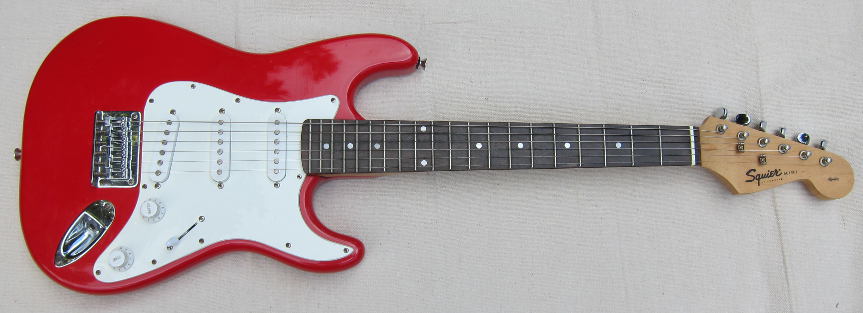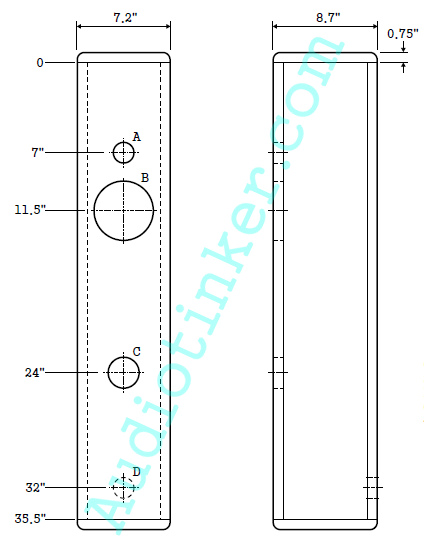Squier Mini Strat Facts, Mods & Odds
The Squier Mini Strat is primarily a beginner electric guitar, sometimes refereed to as a kid's or youth guitar. Funny thing is, more and more adults are staring to see the tremendous value in this instrument, and how darn fun it is to play. It also makes an excellent travel guitar. This page is a portal for how to modify and tweak this "toy" to become a trusted instrument as reliable as any other.

The Squier Mini sells new in the US for only $99 including free shipping. It can be picked up at garage sales, flea markets, and goodwill stores for a fraction of that cost. Its low cost, great build quality and shear abundance also makes it a perfect platform to learn guitar setup and modifications.
The Squier Mini Spec
The spec turned out to be too long to include on this page. I broke it off to its own page that can be found if you click the heading above.
The Various Serial Numbers - Date your Guitar
Follow the link above for serial number information and how you can find out year of manufacture and which plant your Mini Strat was made at.
Squier Mini Mods
Here are some recommended modifications for your Squier Mini. Listed from easy to more involved.
Strings
Not really a mod when you think about it, but have a look at the strings on this guitar. If it is strung up with 9s or thinner, get thicker strings. You should be able to put 10s or even 11s on without modifying the nut of the guitar.
Without going into the physics of strings and tension, the shorter scale length of the Squier Mini requires thicker strings than what would be appropriate on a full size guitar. You may think that the thinner strings will be slacker and therefore easier to play. Not so. The strings will be annoyingly slack and buzz. There is a good chance the action can be lowered with heavier strings as a result.
What will happen is, the tone will be richer, the guitar will be louder (and distort sooner) and you should be able to set the action lower if you so desire. It's a win-win-win-...The downside? Slightly harder to do bends. Unfortunately, few things in life comes for free.
I have a mini that I set up for practicing slide on dropped D tuning, and put 12s on it. However, if you jump to 12s you will need to file the slots in the nut to accommodate the thicker strings. Modifying a nut is a great skill to learn is you want to learn how to set up guitars. Normally, jumping just one gauge thickness (from 9s to 10s in this case) doesn't warrant any modification of the nut.
Lubricate the Nut
This is also so easy it's note really a mod, but rather an improvement in the setup.
Many times you hear people say you need to change out the tuners for a guitar to stay in tune. That may have been true back in the day when the gear ration on most tuners were 12:1 or lower. Today even the cheapest tuners are 14:1 or better, so you can't back-drive them. So what it comes down to is, if your guitar doesn't stay in tune, it is typically not the tuning machine's fault (assuming it is not busted), but rather an issue at the nut. Read on.
The real problem is that the strings doesn't move freely between the tuner and the nut. What happens is, when you tune the guitar, pluck the string and make adjustments, a lot of the tension/slack you induced stays between the tuning machine and the nut. As you start playing, the string starts to slip in the nut slowly as it evens out the tension between the two sections of string. As a result the tuning of that string is drifting and soon enough the guitar is out of tune again. The solution is to lubricate the nut.
The age-old lube is to use pencil lead. Slack the strings, one at a time, so you can slip the strings from the groove in the nut. Take a sharpened pencil and rub it at the bottom of the slot. It doesn't have to be a lot. Put the string back and move to the next one. This way your guitar will play great and stay in tune even with pretty wobbly old tuners.
Output Jack
There are two problems with the output jack on the Squier Mini:
- The nut always seems to come loose
- It is so cheap it seems it could fail at any moment
Follow the link above for information how to change the output jack.
Install New Tuners
If the guitar doesn't stay in tune despite lubricating the nut (see above), or the tuners have been damaged, the tuners will need to be replaced. Here is how it can be done.
Changing the Nut
The nut on the Mini is made of soft plastic - a dead giveaway this is a cheap instrument. There is no reason it couldn't be replaced with a quality material such as Corian or bone.
Make a Mini Jagmaster from A Squier Mini
This is a dream I've had for some time...New body while neck stays the same.
Make a Mini Tele from a Squier Mini
Another dream I've had for a while...New body with small modifications to the peghead. Plans now available.
A Counterfeit Mini - Who would do such a thing?
A tale about a strange guitar.
Recent Articles
-
Speaker Plans
Feb 04, 18 05:23 PM
Speaker plans for download - free pdfs for DIY builders and tire kickers
